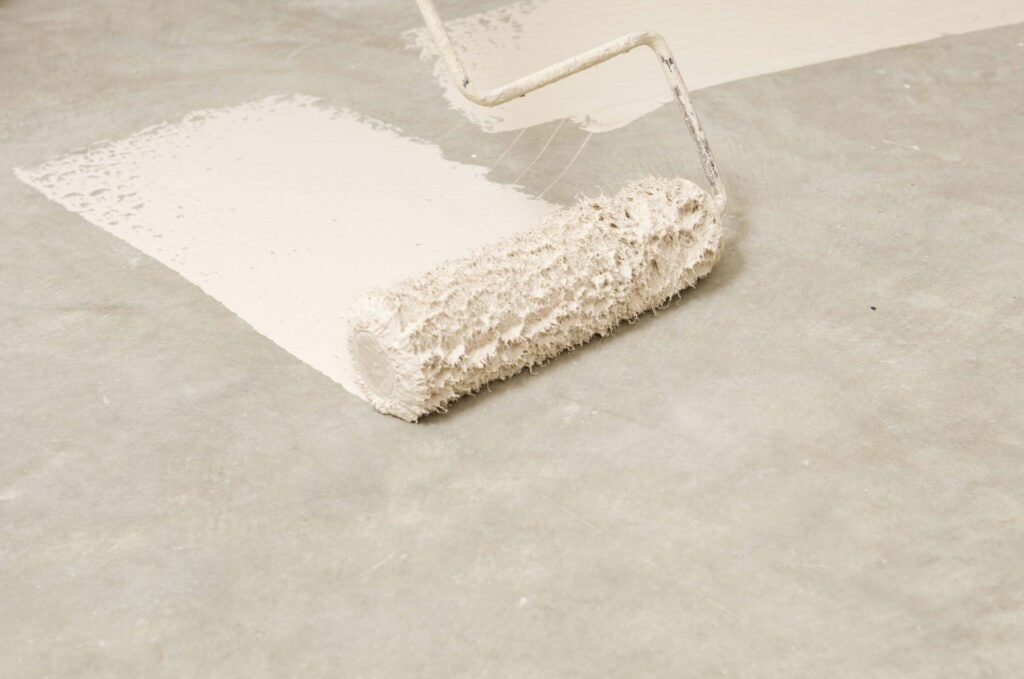When it comes to painting on concrete surfaces, there’s one crucial factor to consider has the concrete been sealed? If the concrete has been properly sealed with a clear sealant, applying paint on top of it may be difficult or impossible. This article explores the reasons behind this limitation and discusses some potential workarounds.
Why Can’t I Paint on Sealed Concrete?
Sealed concrete is coated with a layer of clear sealant that protects it from stains, water harm, and various types of deterioration. This sealant creates a smooth, impervious surface that prevents liquids from penetrating the pores of the concrete. While this protection is excellent for preserving the integrity of the concrete, it also makes it challenging to adhere paint to its surface.

The main issue is that most paints require a certain porosity level or “tooth” to bond correctly. When applied to a smooth, non-porous surface like sealed concrete, the colour won’t have anything to grip onto, making it prone to peeling off over time. Additionally, if the paint doesn’t adhere well, it may flake off easily when exposed to weather conditions or heavy foot traffic.
Are There Any Workarounds?
While it’s generally not recommended to paint directly onto sealed concrete, there are a few alternatives worth considering:
- Use a specialized concrete paint: Some manufacturers produce colours specifically designed for use on sealed concrete. These paints contain additives that bond better with smooth, non-porous surfaces. However, remember that even these paints might not last as long as they would on an unsealed concrete surface.
- Apply a primer first: Another option is to prime the sealed concrete surface before painting. A good quality concrete primer will produce a coarse texture, enabling the paint to stick better. Just remember that priming only provides a temporary solution; eventually, the paint may still start to peel away.
- Stain the concrete instead: If you want to alter the appearance of your sealed concrete without compromising its durability, consider using a concrete stain. Unlike paint, which sits atop the surface, stains penetrate the concrete’s pores, creating a natural-looking paint change that won’t chip or flake off. Remember that stains may offer a different level of colour vibrancy than paint.

- Remove the sealant (carefully): If none of the above options appeals to you, removing the existing sealant from the concrete surface is technically possible. Be cautious, though – improper removal methods can damage the concrete. It’s best to consult a professional contractor who can safely strip the sealant without affecting the underlying concrete. Once the sealant is removed, you can paint the concrete as usual.
Conclusion
In summary, alternative solutions are available, while it could be better to paint directly onto sealed concrete. Choose a specialized concrete paint, apply a primer, opt for staining, or carefully remove the existing sealant – each method offers a different approach to achieving your desired outcome. Before proceeding, take the time to evaluate the advantages and disadvantages of each choice according to your perspective, specific situation and expected results. With proper planning and execution, you can enhance the look of your sealed concrete surface without compromising its longevity.
FOR MORE
For more informative and knowledgeable blogs or articles, you should be visit here https://cronusconcrete.com/
Frequently Asked Questions
Q1. Do I need to prime the floor before painting?
Ans. Yes, it’s highly recommended to prime the floor first to ensure better paint adhesion and uniformity. Use a concrete primer specifically designed for sealed concrete floors.
Q2. What type of paint is suitable for painting on sealed concrete floors?
Ans. Look for paints specifically formulated for concrete surfaces, such as epoxy or acrylic-based coatings. These paints are engineered to provide excellent adhesion and durability on smooth, sealed concrete.
Q3. Can I use a roller to apply the paint?
Ans. Yes, rollers are effective for painting large areas quickly and evenly. However, you may need to use a brush for edges, corners, and other tight spaces.
Q4. How many coats of paint will I need to apply?
Ans. The number of coats required depends on the porosity and texture of the concrete, as well as the desired finish. Typically, two to three coats are sufficient, but consult the manufacturer’s recommendations for specific guidance.
Q5. How long does the paint take to dry?
Ans. Drying times vary depending on the product, temperature, and humidity levels. Follow the manufacturer’s guidelines for drying times, which can range from a few hours to overnight.
